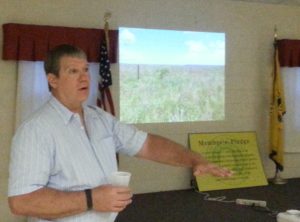The June Chapter dinner meeting a.k.a “Parents’/Guardian’s and Children’s night” was held at the Kings Fork Community House on Wednesday, June 15th at 7pm.
Our guest speaker was Timothy Craig, U.S. Fish and Wildlife Service Region 5 South Zone Fire Management Officer, Great Dismal Swamp National Wildlife Refuge, Suffolk, Virginia. Tim has worked for federal land management agencies for 29 years in fire and law enforcement positions, starting as a GS-4 seasonal Park Ranger with the National Park Service in the southeast. He has worked 8 seasons with the Park Service before accepting a permanent fire job with the Fish and Wildlife Service in Arizona. He has worked at various duty stations in the Southeast, Southwest and Eastern Great Basin over the course of his career. He has been the Zone Fire Management Officer stationed at Great Dismal Swamp NWR since 2002, supporting refuges in the Virginia and West Virginia Zone. The zone supports a very active prescribed fire program, and works with cooperators and FWS Region 4 refuges to manage the wildfire risk in the southeastern coastal plain.
 Tim’s presentation included a variety of slides showing historical as well as recent fires that have occurred in the Great Dismal Swamp. He described how the Great Dismal Swamp area has experienced fires on a recurring basis over an extended period of time. His slides showed both the actual fires as well as their affect on the ecosystem. In many cases, the residue left behind as a result of logging activity acts as a fuel supply that can be easily ignited by lightning strikes. Once the fire gets started, ground fires begin to burn in the organic matter underlying the refuge. This material is referred to as peat and can burn for extended periods of time and is difficult to put out.
Tim’s presentation included a variety of slides showing historical as well as recent fires that have occurred in the Great Dismal Swamp. He described how the Great Dismal Swamp area has experienced fires on a recurring basis over an extended period of time. His slides showed both the actual fires as well as their affect on the ecosystem. In many cases, the residue left behind as a result of logging activity acts as a fuel supply that can be easily ignited by lightning strikes. Once the fire gets started, ground fires begin to burn in the organic matter underlying the refuge. This material is referred to as peat and can burn for extended periods of time and is difficult to put out.
As a result of these ground fires, the actual ground level in the area of the fire has been reduced as much as 6-8 feet in some cases. Even though some of the tops of the trees may not have been too severely damaged by the initial fire, the ground fire kills the trees by burning the roots. Tim’s presentation ended with a slide and discussion of the area’s recovery. Although vegetation returns and the area recovers, the ecosystem is very different from the pre-fire forest structure.
